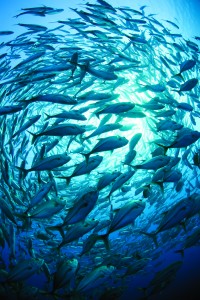Dinner Shouldn’t Be About Going Fishing for Information
- by Guest
Editor’s Note: This guest post is by Beckie Zisser, an ocean advocate at Oceana, the largest international advocacy group working solely to protect the world’s oceans. Bon Appétit Management Company is proud to have partnered with Oceana on its petition to ask Congress to strengthen seafood labeling laws.

Americans eat a lot of seafood. We rank third in global seafood consumption, behind China and Japan, and we spend billions of dollars every year on seafood. But for most Americans, the knowledge of what we’re eating ends with what’s printed on our menu. Most people have little idea about the complex route their fish has taken from the boat to their plate.
Oceana recently released a report comparing the traceability systems in the beef and produce industries in the United States to the seafood industry. So how did they stack up?
It turns out that when you go to a steakhouse and order the filet mignon, the meat you’re served most likely came with information, such as where the animal was raised, where it was slaughtered, and how the meat was processed. Many produce companies have similar systems for tracking the path a fruit or vegetable takes. This type of information is critical for minimizing harm when a foodborne illness outbreak occurs, as it helps authorities pinpoint where in the supply chain the contamination occurred and allows them to recall products from that source.
Unfortunately, no uniform system exists for the seafood we eat.
Although U.S. fishermen are currently required to document where, when, and how a fish was caught, these same standards do not apply to foreign importers, and the reported information is routinely lost along the complicated route a fish takes to the grocery store or restaurant kitchen.
What does this mean for seafood consumers? The fish you think you’re eating may be an entirely different species.
Recent studies have shown our seafood may be mislabeled 25 to 70 percent of the time for commonly swapped species like Atlantic cod, red snapper, and wild salmon. This is often done to disguise species that are less desirable, cheaper or more readily available and can happen at any step of the supply chain.
After DNA testing of seafood purchased in certain cities, Oceana found that 31 percent of seafood tested in the South Florida area was mislabeled. This number follows testing by Oceana that found 55 percent of seafood tested to be mislabeled in Los Angeles and joint testing by Oceana and the Boston Globe that found 48 percent mislabeled in Boston.
So why does the seafood industry lag behind the beef and produce industries in traceability? Historically, the seafood industry has been held to different standards than other industries. Although the Food and Drug Administration is in charge of ensuring that the seafood we eat is safe and properly labeled, the patchwork of laws and many exemptions for the seafood industry leaves the agency with limited resources and authority to do so. The U.S. imports more than 80 percent of our seafood, yet the FDA only inspects about 2 percent at the border, and virtually none of that is inspected specifically for fraud.
Recently, however, there has been some good news for the seafood traceability movement. This summer, Congress introduced the SAFE Seafood Act, which would implement full traceability for all seafood sold in the U.S. The bill would require information such as scientific name, where, when and how the fish was caught, and processing information to follow the fish from boat to plate, as well as require more coordination between government agencies.
Seafood fraud not only cheats customers and honest fishermen and distributors, it could have extremely dire consequences for public health and food safety. We all deserve to make informed choices about the food we consume, and we can only achieve this through a mandatory and consistent seafood traceability system in this country.
You can join Bon Appétit and many others in asking Congress to pass better seafood labeling laws here.